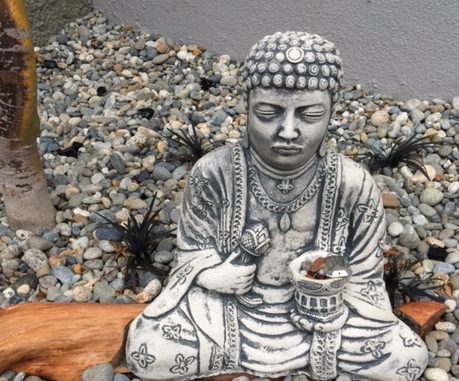Anxiety and IBS go hand in hand.
Getting sick sends anxiety through the roof. So addressing anxiety will speed up gut and adrenal healing.
Healing anxiety is tricky, but I’ve been working on lowering my anxiety for years and have discovered what does and doesn’t work.
Anxiety is a mind body issue. An anxious thought will tighten muscles, flood the body with stress hormones, shut down digestion and cloud thinking. Breathing becomes shallow and erratic.
When the brain sends anxious thoughts to the gut, the gut responds responds by reducing the stream of feel good chemicals to the to the brain, intensifying anxiety more.
My anxiety increased after I recovered from IBS.Getting sick made me lose faith in my body.
I developed tendencies toward hypervigilance, worrying about every strange twinge or pain in my body, wondering if it signified a relapse?
When we lose faith, anxiety swoops in to fill the void.Then the anxiety disconnects us from our body and natural instincts/intuition.
There’s a deep wisdom and grounded guidance that comes from the body. When we cut ourselves off from it we look to our neurotic, erratic mind for guidance. Minds are filled with doubt, fear and confusion.
Our body guidance is always speaking to us, but the voice is drowned out by anxious chatter. For the best guidance we need to quiet anxiety and learn to listen to our body.
Back when I was sick and guided by anxiety, I ate a raw food diet for 8 months because I thought it would heal me. It clearly made me feel worse but I was so stuck in my head and its conviction that I ignored/misinterpreted my body’s complaints.
When there is intense sensation or pain in the body, we tend to check out and flea to our heads for safety.
But then anxiety runs the show.
Following an anxious mind is like watching a scary movie. You may know your thoughts are fictional projections of ‘what if’, but you still respond to them like they’re real. Just like your body does when watching a horror flick.
Your gut doesn’t the difference between fictional thoughts or reality. It responds to whatever movie you are playing in your head.
How I healed my anxiety
My approach was specific, but I learned some general principles that can be applied in other ways.
I began by studying chi gong and tai chi . They are both moving forms of meditation that focus on slowing down and noticing body sensation. Then a few years later I added the practice of yoga nidra, a guided meditation that calms the nervous system and releases trauma. It’s down laying down in a posture of surrender.
These are called somatic therapies because they focus the mind on observing the body and its sensations.
A year ago, I added cognitive behavioral therapy to the mix to start examining my thought patterns. My strong connection to my body and intuition made this talk therapy so much more successful than previous attempts.
Chi gong, tai chi and yoga nidra focus on slowing to feel into the body we’ve been ignoring. This was hard at first. I tend to move fast and distract myself from feeling too much emotions or sensation. This is typical for sensitive types who get easily overwhelmed.
But as I practiced connecting to my body, I developed capacity to process more emotion and sensation without freaking out.
Eventually my head became sharper, my intuition was easier to hear and I was less reactive to the world.
By connecting to my body, I was able to connect to a different part of my brain. Not the anxious bit but rather the part that could observe itself with neutrality.
It’s hard to fix a troubled head when using the same troubled head. Body connection helped me stay present and see myself with clarity. I was able to recognize thought patterns I never noticed before because they usually moved with great speed.
I was able to use cognitive behavioral therapy to identify negative thoughts without buying into them. This helped me let them go.
Many ways of connecting
Here are two experiments you can try at home to get a taste for how it feels to connect to the body.
When you’re relatively calm, take a walk.
Instead of distracting yourself with thoughts or your phone, focus on your senses. Take in the scenery with your eyes, feel the breath going into your lungs, notice how your feet feel when they touch the pavement. Do a scan inside your body to see where you are holding tension. Focus on your sense, sight, sound, feel, touch. As you connect to and observe your environment you become present.
This next one is tougher but more interesting.
Think about an anxious thought and notice how you feel physically. Do your palms get sweaty? Does your head get hot? Are your shoulders near your ears? Is your throat tight? What does your breath do? Don’t do anything about it, just notice.
When you learn how stress effects your body specifically you now have the tools to disarm that reaction. Use those sensations to stop the physical response to anxiety. With practice this can work even on panic attacks.
Each emotion has a corresponding contraction or sensation in the body. By finding your anxious tensions you can learn to release them with breath or visualization.
Most people diffuse anxiety by numbing out. Addictions, technology, staying busy and being distracted are typical ways to manage anxious thoughts or feelings. It might feel good but it’s a band aid and a crutch.
Moving slowly and noticing how you feel is the remedy.
At first you may not feel much as you connect to your body but with practice you’ll feel more and move past your numbness and wall of protection.
You may find this maddening, boring or overwhelming at first. I did. The key is to take it slowly and find a teacher to work with who will support and motivate you.
If you learn how to safely return to your body you can heal even debilitating anxiety.
What you need to know about meditation
Learning how and why meditation work is quite motivating.
The complaint I hear most from people about meditation is that they’re bad at it.
There is no being bad at it. You either do it or you don’t but you can’t do it badly. Here’s why…
The purpose of meditation is not to stop thinking. It’s to observe your thought stream without getting too caught up. If you do get caught, just notice that you did it.
This process of observing your mind is what begins to give you distance from your thoughts, so you stop believing in and reacting to the fiction. Remember the horror flick?
It may not seem like much is happening but you’re training your body and mind to be less reactive. You are building a tolerance for anxious thoughts.
Meditating will give you a deeper insight into how your head works.
I assumed I knew my thoughts before I started this work.
Then I discovered “meta emotions“. This is the name I’ve given to the emotions I have about my emotions. Instead of feeling my emotions I was judging them.
I got depressed about my sadness, judgemental of my judgements, stressed about my stress and anxious about my anxiety. I was even perfectionistic about letting go of my perfectionism.
When you allow yourself to feel an emotion you process it and let it go. If you stuff that emotion down, it gets trapped in your body and creates white noise in your nervous system. To be healthy you want to feel and process your emotions so they are released. If you don’t you’ll create emotional clutter in your body.
Finding faith again…
I’ve been working on regaining the faith I lost from getting sick.
Faith is so powerful. Just look at the placebo effect. The sugar pill works because you believe it will.
Faith is also your best weapon against anxiety. The two can’t coexist. Not if your faith is real and deep.
Faith and intuition will wipe away doubt, confusion and fear. Intuition will guide you, faith will make you feel safe and secure.
When you connect to your body wisdom, you’ll stop diagnosing yourself from a place of anxiety, fueled by late night google searches.
Next time you’re googling and anxious, get out of your head and look for somatic or meditation-based therapies/classes in your area. Or go take a walk and immerse yourself in your senses.
I hope this was helpful. This might be new or abstract information but I had to share it because I know from experience it works. It has worked for me and many others.
It’s not a quick fix of course, but it has worked better for me than anything else I’ve ever tried. So I felt compelled to introduce the concept of somatic therapy and embodiment for healing anxiety.


